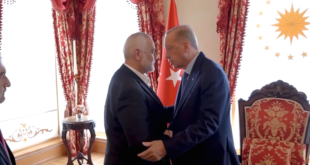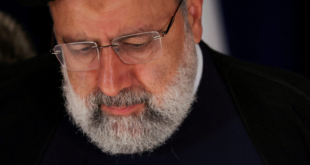The US Congress finally passed and President Joe Biden signed a law on long-term assistance to Ukraine, including military assistance, totaling almost $61 billion. Without this package, Ukraine’s situation would have become critical. True, even with these funds, Ukraine’s military budget will still not reach parity with Russia’s. Moreover, approximately half of the amount allocated by the United States will be spent on armaments, and a little more than $11 billion will be spent on weapons that can be delivered quickly. According to The Insider’s calculations, Russia’s military spending is approximately one and a half times larger than Ukraine’s, even taking into account all international assistance.
Long-awaited approval
After almost six months of delays and fierce debate, the US Congress approved a $60.8 billion aid law for Ukraine. President Joe Biden signed it on April 24 and announced that supplies of critical weapons to the Armed Forces of Ukraine would resume within a few hours. Disputes over the law on assistance to Ukraine have been going on since the fall of 2023 and caused an acute crisis within the American political machine. Initially, assistance to Ukraine was included in one document with support for Israel, Taiwan and a number of other initiatives related to US national security. However, the Republican majority in the House of Representatives has long made the inclusion of measures to protect the southern border from an influx of illegal migrants a condition of the vote.
In early April, the single bill was divided into four. On April 20, the House of Representatives approved the Ukraine assistance bill. On April 23, the Senate voted for him . On April 24, the Pentagon announced the first $1 billion military aid package for Ukraine.
How much military aid will Ukraine receive?
If we evaluate the bill as a whole, the funds allocated for Ukraine are impressive. The total amount intended for the purchase and supply of weapons exceeds both the European Peace Fund (which is also designed until 2027) and funding for the purchase of weapons from the Ukrainian budget. And this despite the fact that, as independent military analyst Colby Badvor explained in a commentary for The Insider, of the $60.8 billion prescribed, less than half is spent on military aid itself.
First, $7.8 billion is allocated for the supply of weapons and military equipment from the stocks of the US armed forces under the PDA mechanism . Together with the $3.9 billion unspent in previous periods, the total amount of funds for operational supplies thus amounts to $11.7 billion .
Second, $13.8 billion is reserved for the USAI program . It provides for long-term purchases of military products; all deliveries announced by USAI will appear on the battlefield, at best, after many months, if not years.
Thirdly, $1.6 billion comes from the FMF (Foreign Military Financing) loan program, designed for long-term military construction projects.
All together, this amounts to $27.1 billion, of which only $11.7 billion can be spent on operational supplies that can influence the situation at the front in the short and medium term. In reality, the amount of funds available under the PDA will be less, since the US Department of Defense has already demonstrated reluctance to fully utilize authorized limits without financial assurance of reimbursement of the transferred military equipment. With some stretch, the category of military assistance can also include preferential budget loans worth $8 billion – if you add them, you get, at best, $35.1 billion.
Military aid in the US-approved Ukraine aid bill accounts for $35 billion.
The adopted law also contains a clause allocating $13.4 billion to compensate the US Department of Defense for equipment and weapons already supplied to Ukraine or intended for delivery in the future. Badvor considers this amount disproportionately small compared to the required volumes.
How important is US support for Ukraine?
In total, from February 2022 to December 2023, the US Congress approved the allocation of $113.4 billion to finance various expenses related to the Russian invasion of Ukraine. Support is provided through several programs and is conducted primarily through the Departments of State, the Department of Defense and the United States Agency for International Development (USAID).
Direct military assistance (security assistance) is administered by the US Department of Defense within the framework of the above-mentioned USAI, PDA, FMF and European Deterrence Initiative (EDI) programs. An important nuance is that the total amount of military assistance for Ukraine also takes into account war-related expenses for the US military presence and operations in Europe.
Of the $113.4 billion, the US Department of Defense was responsible for providing $62.3 billion:
$18 billion under USAI;
$25.9 billion under PDA;
$18.4 billion for US operations in Europe.
Assistance for Ukraine has so far been formalized in four acts:
Ukraine Supplemental Appropriations Act, 2022 in March 2022 for $13.6 billion;
Additional Ukraine Supplemental Appropriations Act, 2022 in May 2022 for $40.1 billion;
Ukraine Supplemental Appropriations Act, 2023 in September 2022 for $12.3 billion;
Additional Ukraine Supplemental Appropriations Act, 2023 in December 2022 for $47.3 billion.
Of this entire volume of $113.4 billion, according to Badvor, military equipment and weapons transferred to Ukraine account for only $20 billion. According to official data , the total cost of all PDA packages from August 2021 to December 2023 is $23.9 billion, of which Of these, $9.2 billion were allocated in 2022 and $14.6 billion in 2023. The total value of USAI contracts since the beginning of the war is estimated at $18.6 billion, and, of course, not all of them have been fulfilled.
In total, according to the Ukraine Support Tracker resource (as of January 15, 2024), the United States is in 2nd place after the EU in terms of total assistance (including financial and humanitarian), but in absolute first place in terms of military assistance: $42.2 billion in compared to $17.7 billion from its closest competitor, Germany.
Why did the Republicans still support aid to Ukraine?
According to one version, the decisive factor for some Republicans, led by House Chairman Mike Johnson, in reaching a compromise with Democrats regarding the approval of an aid package for Ukraine was the speech of CIA Director William Burns, who announced the threat of a military defeat of the Armed Forces of Ukraine without American support.
Another version is the efforts of the head of the Foreign Relations Committee in the House of Representatives, Republican Michael McCaul. Finally, the influence of Ukrainian co-religionists personally on the devout Baptist Johnson, on whom the voting procedure depended, is mentioned .
The Insider’s sources in Washington say Mike Johnson was in favor of the bill from the first day the bill was introduced, but it took a long time to “sell” it to the Republican Party as a whole. The compromise option was to take into account the demands of Donald Trump’s supporters to include a mechanism for the return of soft loans into the document and at the same time the Democrats supported Johnson against internal opposition from radical Trumpists who threatened to remove him from office.
In addition, military assistance for Ukraine is an important source of investment in the American military-industrial complex itself. According to estimates by the Washington Center for Strategic and International Studies, of the $113 billion in spending related to the war in Ukraine approved by Congress as of April 18, 2024, more than half—$68 billion—will be spent in the United States.
How much does the war cost Russia and Ukraine?
Direct military assistance for the Armed Forces of Ukraine from the approved package of $60.8 billion amounts to $35 billion at best. But it should be borne in mind that the stability of Ukraine as a state as a whole also depends on other budget expenditures. Ukrainian officials admit that without external assistance they will not be able to pay the salaries of 500 thousand teachers, 1.4 million civil servants and the pensions of 10 million pensioners.
Ukrainian officials admit that without external assistance they will not be able to pay salaries for teachers, civil servants and pensions for retirees.
In November 2023, Finance Minister Sergei Marchenko, in an interview with the Italian publication Corriere della Sera, estimated Ukraine’s needs for external assistance for 2024 at $41 billion, of which $29 billion were not covered at that time. In total, in 2023, Ukraine received $42.5 billion from international partners.
Ukraine’s defense spending for 2024 is planned at 1.2 trillion hryvnia, that is, about $30 billion. Together with American assistance of $35 billion and assistance from all other partners , the total costs of the war will most likely reach $100 billion .
At the same time, in Russia in 2023, 13 trillion rubles were spent on war in the broad sense of the word (including security and secret articles), and it is planned to allocate even more for 2024 – 15 trillion rubles. At current exchange rates, this is more than $160 billion . Experts estimate Russia’s direct military spending for 2024 more modestly – in the range from $121 billion to $132 billion .
In other words, even with American help, Ukraine’s military budget will not reach parity with Russia’s. At the same time, the cost of equipment and weapons supplied to the Armed Forces of Ukraine is significantly higher, since it is carried out under contracts from American and European industry with a higher unit cost of labor, raw materials, electricity and other things than in Russia. Accordingly, the gap in providing troops at the front with ammunition, equipment and other resources may be even greater than the difference in the monetary assessment of military expenditures.
Even with American help, Ukraine’s military budget will not reach parity with Russia’s
Most importantly, the US law on aid to Ukraine does not create a long-term mechanism for financing the Ukrainian armed forces during the war. Given the upcoming presidential elections, it is possible that the Americans have accepted the last major aid package for Ukraine in the foreseeable future. That is why NATO Secretary General Jens Stoltenberg is promoting the idea of creating a €100 billion aid fund for Ukraine over five years under the auspices of the alliance.
Some experts say there is a need for even more significant investment in the Ukrainian army. Sir Richard Barrons, the former head of the United Kingdom’s Armed Forces Command, said in November 2023 that for the Ukrainian Armed Forces to win, €75 billion per year is needed for 2-3 years. So far, such a level of funding is not expected even in the most daring forecasts.
What can we expect at the front now?
According to the nomenclature of the newly announced military assistance package for the Ukrainian Armed Forces published by the Pentagon, it will include:
SAM RIM-7 and AIM-9M;
SAM for Stinger MANPADS ;
Small arms and ammunition for them, including 12.7 mm caliber – for destroying drones;
Additional ammunition for HIMARS MLRS ;
155 mm and 105 mm artillery ammunition;
60 mm mines for mortars;
Bradley infantry fighting vehicle;
Armored vehicles such as MRAP and HMMWV;
Logistics support vehicles;
Tactical tractors for transporting weapons;
Missiles for TOW ATGM ;
Javelin and AT-4 ATGMs;
Airborne precision weapons;
Equipment for airfields;
Anti-tank and anti-personnel mines;
Demolition materials for clearing rubble;
Night-vision devices;
Spare parts, field equipment, training weapons and other support equipment.
Many of these weapons seem extremely important in order to improve the situation at the front right now (for example, in the Ocheretino area north of Avdeevka, where the threat of a Russian breakthrough is high). Artillery ammunition, in which Russia’s superiority, according to the head of the US European Command, Chris Cavoli, could soon reach 10:1, is necessary to defeat both advancing Russian columns and counter-battery warfare . In this capacity, as one of the Ukrainian military officers writes , they cannot be replaced by FPV drones . In his opinion, artillery, anti-tank systems and armored fighting vehicles play a key role in repelling attacks by Russian armored vehicles .
All the above categories are included in the new package. In particular, it is worth paying attention to the M2 Bradley infantry fighting vehicles, which performed excellently in defense in the Avdeevka area, not only against infantry , but also in the fight against modern Russian tanks . To destroy enemy armored vehicles, Bradley carries the BGM-71 TOW ATGM; ammunition for them is also being prepared for delivery to Ukraine.
On the other hand, lighter equipment such as HMMWVs and MRAP-class armored vehicles seem no less important in order to somehow protect the infantry in the front line in conditions of constant exposure to Russian artillery, FPV drones and airdrops , making standard operations such as rotation of personnel, evacuation of the wounded and supply of ammunition.
Ammunition for air defense systems also looks very important and timely. Missiles for the Stinger MANPADS will be useful, at a minimum, in the fight against Russian front-line aviation, which feels quite unpunished at the forefront. At the same time, Ukraine urgently needs, for example, additional Patriot PAC-3 air defense systems and missile defense systems for them, in order to counter regular attacks by Russian ballistic missiles on rear areas and cities. Whether the United States will be able to allocate these systems for Ukraine (which most European partners are in no hurry to part with) is still unknown.
In a commentary for The Insider, Colby Badvor points out that the provision on the transfer of long-range (with a range of 300 km) versions of ATACMS missiles (M39A1, M48, M57) is written in vague language and is not binding, but political pressure is on President Joe Biden regarding deliveries This type of weapons will make it possible to achieve a turning point in this issue. Moreover, according to Reuters, such missiles were included in the previous package, formed in March – before the allocation of additional funding, and were already used against targets in Crimea.
It is worth noting the pessimistic assessments of the adopted law. Many Ukrainian military analysts fear that packages of the same magnitude may not be expected, and the funding already accepted will not only make it possible to achieve equality of opportunity with the Russian army, much less carry out army-level offensive operations. According to such pessimistic analysts, there will be barely enough help to prevent the front from collapsing, and in 2025 Ukraine could find itself in a very difficult situation.
 Eurasia Press & News
Eurasia Press & News



